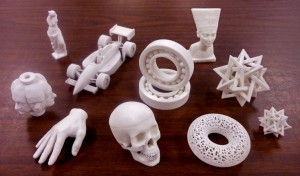Every now & then we stumble upon news articles highlighting rave reviews on the miracles of 3D printing technology. What’s this all hype about in real sense? How does it benefit industries at large? And if it can, why have we not seen its mass production yet? Such and so many other questions might have made you to scratch your scalp several times. Worry not, here and now we explore the realms of 3D printing technology leading you to the BIG Picture!
‘Course you know that 3D stands for 3-Dimensional printing. Still, what does it print anyway?
The objects that you’re seeing in the picture were all 3D printed in a layer-by-layer process. The machine (3D printer) materializes whatever concept you have in mind. There are several top-notch designing/modeling tools available like AutoCAD & Solidworks to tinker with for the purpose. Literally, you can print anything your mind is capable of conceiving. As the saying goes: the only limit is your imagination!
In a foreseeable future, 3D printing will put an end to physical labor in manufacturing, consequently generating more white-collar jobs which would be advancement indeed, if put into perspective. Not only that, even the huge trade imbalance that we witness among the nations today will also be counteracted. With 3D printers we’re able to print custom components from small-scale to larger depending upon our requirements. Thus, the economic salvation from having to import everything from manufacturing giants.
Although, the technology is being adopted in all mainstream consumer markets (autos & other product development companies). We further limit our discourse to the niche-market of medicine, where it’s spurred a kind of revolution. Take a look at the news headlines which we’ve compiled here.
“Food and Drug Administration approved a 3D printed face implant that can be customized for individual patients in need of facial-reconstruction surgery.” (CNET)
“Researchers are using 3D printing in order to make more custom-tailored body implants.” (Journal: Nature, Biotechnology)
“Doctors are using 3D printed models for surgical assistance, as in this case of vertebra.” (Mashable.)
The possibilities are truly endless, and the links above are inadequate to sum up just how much medical applications are expanding, and how rapidly, with 3D printing being the game-changing technology.
Read this amazing article: 12 Things We Can 3D Print in Medicine Right Now by Bertalan Meskó, MD, PhD & a medical futurist
Let’s now stir our discussion towards 3D printed prosthetics. Also, recall that we mentioned something called mass production in the beginning of this article. So, how can we achieve it?
According to a professor of Economics at the University of Texas, Daniel S. Hamermesh, the cost of a product has an inverse relationship with the rate of productivity. That is, the price of any product dwindles down for buyers whenever there’s an increased productivity in the manufacturing sector.
Up until now, the cost for upper extremity device (arm) varied from $3,000 to $30,000, which was unaffordable for fiscally less fortunate amputees.
The Big Picture!
Grit 3D, a biotechnology 3D printing startup in Karachi aims to change that scenario. With 3D printing, holding the reins of manufacturing, the prosthetic costs much lesser than that.
Their work has gained quite a momentum recently with a highly motivated team of young individuals and we see every possibility for Grit 3D to achieve the initial goal. That was to increase the affordability of prosthetics, with the functionality improved simultaneously.



